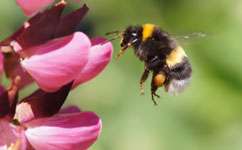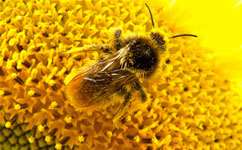Studies highlight differences between banned pesticides

Two separate studies have added new weight to the idea that some varieties of controversial neonicotinoid pesticides are less harmful to bees than others.
The research tested the effects of feeding two different neonicotinoid compounds, thiamethoxam and imidacloprid, to bumblebees. The EU recently banned both pesticides over concerns about their effects on bee health.
Ian Laycock, from the University of Exeter, led the studies.
'We found that both thiamethoxam and imidacloprid were capable of repressing feeding and brood production in bumblebees,' he says. 'But with thiamethoxam this only happened with very large concentrations of the pesticide – concentrations that bees are unlikely to encounter in the environment.'
In contrast, imidacloprid reduced both egg production and pollen consumption by half even at the very low concentrations that bees are likely to encounter when they forage on treated crops.
'We think this occurs because imidacloprid produces a stronger repression of feeding in bumble bees than thiamethoxam, and this imposes a greater limitation on the bees' ability to produce eggs,' says Laycock.
'Brood production is particularly important in bumble bee colonies because the number of eggs and larvae a colony produces can dictate how many workers it has - and colonies with more workers tend to be more successful.'
'In particular they produce more queens that go on to found new colonies and keep the colony cycle going the following year. So our results raise further concern about the threat of imidacloprid to bumblebees.'
But the research also had some better news for bees. After two weeks' exposure, the bees were allowed to recuperate, and seemed to bounce back well.

This kind of 'pulsed' exposure is designed to replicate the scenario in the wild, where bees feed on mass-flowering crops, like oil-seed rape, for a window of just a few weeks while they're in flower. When the bloom is over, wild bees often switch back to pesticide-free wildflowers.
While the scientists tested imidacloprid on regular colonies, the research on thiamethoxam was carried out on micro-colonies, each made up of four worker bees kept apart from the queen. This allowed the scientists to monitor responses such as feeding, egg-laying and brood survival in precise detail.
In natural colonies, the queen bee does most of the brood production herself, and Laycock acknowledges that the lack of queens in the micro-colonies does limit the study's ability to replicate the bees' real-world environment.
But he believes the research still gives a useful insight into the different effects of neonicotinoid compounds. And he maintains that lab studies have an important role to play in gathering evidence on pesticides.
'It's impossible to perfectly replicate the real world in the lab, and for that reason some people will always question the environmental relevance of lab studies,' he says.
'But carefully designed lab studies are vital because, unlike field studies, we can precisely control variables such as the concentration or dose of the pesticide that the bee receives.'
In December last year, the EU introduced a two-year moratorium on neonicotinoids. The UK voted against the ban, citing a lack evidence of harm to bees in field studies.
Laycock believes that the evidence against imadacloprid is probably strong enough to justify a temporary ban, giving researchers more time to look into its effects. But he says we shouldn't tar all neonicotinoids with the same brush.

'What our study shows is that we cannot simply apply the conclusions about the safety of imidacloprid to other neonicotinoids,' he says.
He is also concerned that the moratorium could encourage farmers to use alternative pesticides on their crops, whose effects on bees are unstudied, and may prove to be even worse.
These thoughts are echoed by Dr Chris Connolly, from the University of Dundee, who was not involved with either study.
'Whether or not these pesticides are responsible for bee decline, there is clear evidence that they have an effect, and so the moratorium seems like a wise precaution.'
'But it would be totally unwise if they are just replaced with other compounds, which we know very little about - it's irrational to set the bar higher for one pesticide than all the others. The whole thing needs to be looked at a bit more scientifically.'
One potential alternative, belonging to a group of chemicals called pyrethroids, was the subject of a separate lab study at Royal Holloway, University of London. Colony exposure to the pesticide was shown to reduce the size of bumblebees' offspring, posing a potential risk to colony success.
More information: Laycock I, Cresswell JE (2013). "Repression and Recuperation of Brood Production in Bombus terrestris Bumble Bees Exposed to a Pulse of the Neonicotinoid Pesticide Imidacloprid." PLoS ONE 8(11): e79872. DOI: 10.1371/journal.pone.0079872
Ian Laycock, Katie C. Cotterell, Thomas A. O'Shea-Wheller, James E. Cresswell. "Effects of the neonicotinoid pesticide thiamethoxam at field-realistic levels on microcolonies of Bombus terrestris worker bumble bees." Ecotoxicology and Environmental Safety, Volume 100, February 2014, Pages 153-158, ISSN 0147-6513, dx.doi.org/10.1016/j.ecoenv.2013.10.027.
Journal information: PLoS ONE
Provided by PlanetEarth Online
This story is republished courtesy of Planet Earth online, a free, companion website to the award-winning magazine Planet Earth published and funded by the Natural Environment Research Council (NERC).


















